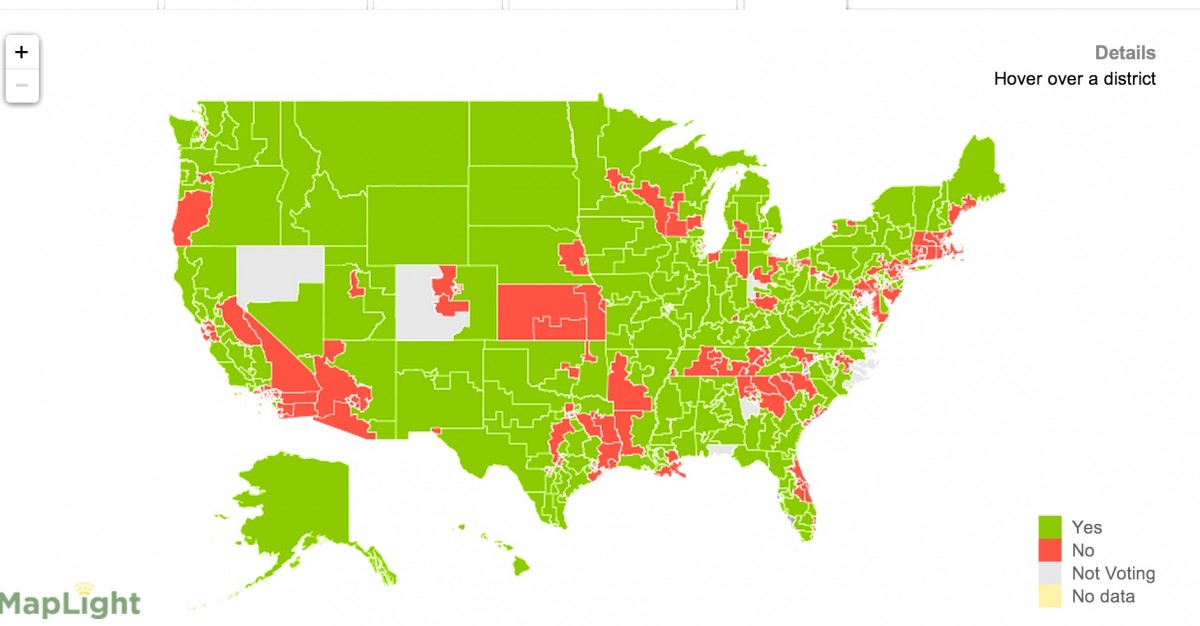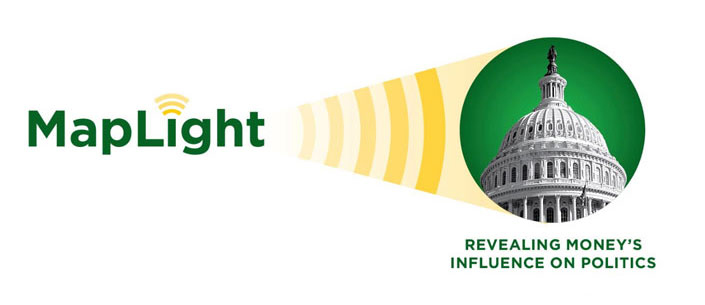Navigating the intricate webs in which money influences politics can be a tricky business. Some reporters try scanning state and federal electoral financial reports, for example, then balancing those numbers with politicians' legislative agendas and voting records – a daunting task, to say the least. With an additional torrent of dark money contributions flooding the scene of late, and a proliferation of shadowy "non-profit" advocacy groups further muddying the waters, one's tempted to give up the hunt for fiscal political truth altogether.
However, even as those doling out cash in exchange for policies continue to inject more green into our elections with every passing Supreme Court decision, a group of watchdogs at Maplight has upped the ante by introducing a new interactive tool to track not only the level and location of political donations, but how the money impacts specific pieces of legislation.
Rolled out in June of this year, Maplight’s "Vote Map" enables users to access specific and substantial research about the corrupting influence of money in politics, reported in an interactive and visually engaging style.
Select any congressional bill – let's say the contentious farm spending bill or, more recently, the North American Energy Infrastructure Act – and “Vote Map” lays out for you in simple detail the breakdown of roll call votes on that piece of legislation. Presenting a full map of the United States and its highly gerrymandered congressional districts, the site exposes users to a patchwork of green and red – with the political names, parties and district numbers associated with any piece of legislation.
The interactive tool also gives people the ability to track not just corporate donations but large individual contributions to legislators as well, which are reported as required throughout the country. In a few clicks you can navigate from a district-by-district breakdown of votes on, say, a natural gas pipeline, to a map that informs you how much money a representative just accepted in donations from, for example, General Mills or Monsanto. The picture becomes clearer once you see, and actually visualize, the dollar donation numbers side by side with individual congresspeople's voting records on bills that affect those donor corporations.
Shining a Light in the Darkness
Maplight brings together the combined resources and talents of researchers, writers, web designers, database specialists and political analysts with the express purpose of exposing campaign financing to light. Part political journalism, part public policy watchdog, the website works with affiliate partners – including Opensecrets.org, Govtrack.us and Followthemoney.org – to simplify, and demystify, the vast pipelines of influence that lead from campaign to legislation.
Initially dedicated to tracking the influence of election money within California, Maplight has expanded its coverage across different states and the federal government. It has won honors and been nominated for prestigious awards in the fields of journalism, government transparency and tech innovation as it quickly gains the attention of politicians, journalists and citizens alike.
An Evolving Issue
With the financial turmoil and crash of the last decade, and the resulting bailouts and immunity from investigation or prosecution enjoyed by the Wall Street elite, money in politics has found a greater ear in the American conversation. No longer just an issue for watchdogs and a marginal numbers of elected officials, campaign finance reform is steadily joining the arena of other hot button voter topics like abortion, gay marriage, guns and taxes.
The Occupy Movement of 2011 increased public scrutiny on issues surrounding political access and influence, further elevating the corruption of election spending into the mainstream. With growing awareness about the Citizens United and McCutcheon v. FEC Supreme Court decisions, which opened the floodgates wider for big money to dominate the political process, public activism on the issue has also increased. Organizations like Move To Amend and the New Hampshire Rebellion have taken strides to raise awareness and leads calls to action – and not just Lawrence Lessig's MayDay SuperPAC but other PACs and campaigns are now using campaign finance disclosures as ammunition to fuel election battles.
Though the evolving nature of institutionalized corruption still presents challenges to those trying to create a more transparent, publicly accountable electoral system, an array of new tools has become available to expose big money’s influence on legislation. Now it's up to the public to use that toolbox, become advocates on the issue, and help enable true reform so that people govern America again – not private wealth and corporate interests.
3 WAYS TO SHOW YOUR SUPPORT
- Log in to post comments













